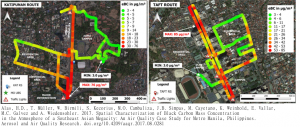by John Leo Algo
Results of the measurements of Black Carbon in three sites in Metro Manila: “Spatial Characterization of Black Carbon Mass Concentration in the Atmosphere of a Southeast Asian Megacity: An Air Quality Case Study for Metro Manila, Philippines (Alas etal, 2017)”, have been recently published in Aerosol and Air Quality Research. A copy of the article is in the following link: http://www.aaqr.org/article/detail/AAQR-17-08-MAPS-0281). And a summary follows.
Black carbon (BC) is an ultrafine particle found in PM2.5 that can absorb and trap heat within the atmosphere. It also carries toxic substances that may cause respiratory and cardiovascular diseases. These impacts are intensified in urban centers like Metro Manila due to high BC emissions from local sources such as transportation. To obtain a better understanding of its impact, the Metro Manila Aerosol Characterization Experiment (MACE) was conducted in 2015 by the Leibniz Institute for Tropospheric Research, Manila Observatory, Ateneo de Manila University, University of the Philippines and De La Salle University. Two of the busiest streets of Metro Manila, Katipunan Avenue and Taft Avenue, were monitored throughout the summer season. The campaign revealed hourly BC levels reaching 138 µg/m-3, which are two to five times higher than in other Asian megacities such as Hong Kong and Seoul. The mean concentration along Taft Avenue exceeded the Philippine air quality annual guideline value of 25 µg/m-3 for PM2.5. The highest BC concentrations were observed during morning (6-9 AM) and evening (5-9 PM) “rush hour” periods at areas 300 meters from the roads. These roadside areas are also crowded with high pedestrian traffic, raising concerns about potential health impacts.


